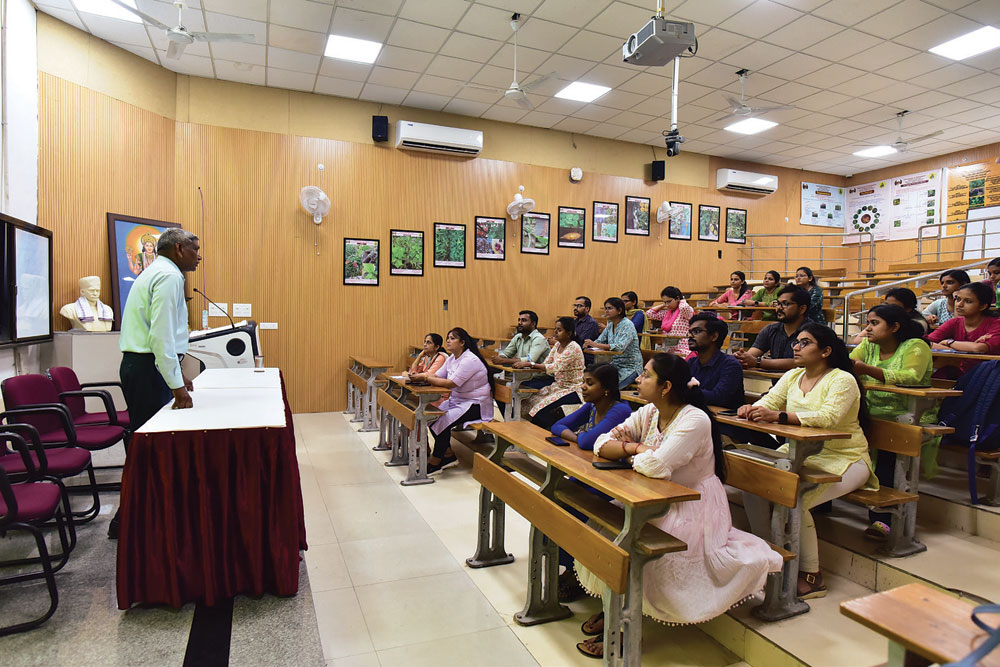Natural Solutions
Mainstreaming the potential of AYUSH in health education
 KN Dwivedi
KN Dwivedi
 KN Dwivedi
|
21 Jul, 2023
KN Dwivedi
|
21 Jul, 2023
/wp-content/uploads/2023/07/Natural-Solutions1.jpg)
An experiment Underway At The Institute Of Medical Sciences, Varanasi (Photos: Amar Deep Sharma)
AN INTEGRATED healthcare system is the need of the hour. The term integration refers to a conscious effort made by the biomedical sciences and health professionals to find and evaluate the efficacy of various traditional medical systems, modalities, techniques, as well as their application for inclusion into the continuum of care in accordance with the institutional healthcare system’s current constraints. Unfortunately, this meaning is rarely used. Instead, integration is often used to refer to the mainstream biomedical model’s dominance over practice.
Ayurveda, yoga, naturopathy, unani, siddha, sowa-rigpa, homoeopathy, collectively covered under the Ministry of AYUSH, represent a pluralistic and integrative scheme of health services. The National Health Policy (NHP) 2017 has strongly advocated mainstreaming the potential of AYUSH within a pluralistic system of integrative healthcare. The NHP 2017 emphasises on the need for integrating AYUSH in the National Health Mission, research and education. The policy focuses on creating protocols for integrating AYUSH into conventional medicine. This has enormous potential for safe and affordable prevention and rehabilitation. It encourages an integrated strategy for reducing the morbidity and preventable death caused by the rising burden of non-communicable illnesses. It encourages the adoption of an integrated strategy at a comprehensive primary healthcare network. It emphasises on research into mainstreaming AYUSH’s potential.
Symptomatic treatment, medicine prescription, laboratory testing, disease awareness and social education regarding prevention and primary care seem to be the mainstay of today’s healthcare systems. Clinical acumen has taken precedence, leaving out body-mind synergy-based therapies in physiology, nutrition, food, lifestyle, and behaviour that ayurveda incorporates.
About 80-90 per cent of India’s population uses ayurveda and other traditional systems of medicine to meet their healthcare needs, according to reports. Safety of this system is attributed to time-tested use and substantiated by scientific evidence. The Indian medical curriculum should be rooted in the traditions and heritage of Indian knowledge, bringing out the best of traditional and modern science, highlighting national priorities and understanding the actual needs of patients. The basic ideas of the AYUSH health system should be incorporated at the undergraduate level and a mandatory bridge course should be added for mid-level healthcare providers.
“Healthcare education needs to be re-envisioned so that the duration, structure, and design of the educational programmes need to match the role requirements that graduates will play,” says the National Education Policy (NEP) 2020. The first step in any reform of the healthcare system must begin with basic medical education, that is, at the undergraduate level. Basic medical education must be integrative, which means that all students of the biomedical system must understand the basics of AYUSH, and vice-versa.

The main idea behind the introduction of AYUSH to the students of allopathy medicine is to develop the confidence that in cases of some diseases, especially chronic ones and lifestyle disorders, AYUSH can give better results. Introductory lectures related to the clinical trials of AYUSH medicines in various diseases should be taught from published scientific journals. These introductory lectures must be data-oriented and related to the efficacy and safety of the AYUSH medicines.
Despite the concurrence of AYUSH and allopathic frameworks in India for a long time, many specialists of one framework do not know about the way of thinking, science and utility of the other framework. Interestingly, both allopathic and AYUSH professionals endorse drugs from one another’s framework of medication. In one review, 12 per cent of the medications endorsed by allopathic professionals were ayurvedic drugs, while 48 per cent of those recommended by ayurvedic experts were allopathic medications.
At the same time, patients themselves use conventional medication along with allopathic medication without informing their specialists treating them. A review said conventional medication was used correspondingly with allopathic medication by 60 per cent patients, and just 19 per cent patients wilfully informed their specialists. Since patients getting allopathic treatment might have taken AYUSH medicines correspondingly, it would be helpful for a specialist of allopathic medication to know about these frameworks. Such knowledge will help decide the line of treatment for patients as well as keep unfavorable impacts at bay.
To meet this challenge, a postgraduate diploma or other certificate courses may be designed for better understanding of modern medicine and the AYUSH system of medicine. The aim would be to prepare health professionals to combine useful and relevant parts of different systems of medicine. Such type of courses should be open for students from all streams of healthcare.
High-quality, interdisciplinary research on basic concepts of ayurveda and other AYUSH systems could open global leadership opportunities for India. Standardising and validating ayurvedic medicines and establishing robust and effective quality control mechanisms for herbal drugs should be reinforced. Steps should be taken to strengthen ayurgenomics, which integrates concepts of ayurveda with modern genetics research.
At the level of clinical practice, an integrative healthcare system, in which patients can get treatment from any medical system (either biomedical or AYUSH), depending on their pathology and evidence to treat it, should be formulated. If this is embraced, the treatment would be patient-centric. Every public health centre and private sector hospital as well as clinic should work more on the inclusion of this patient-centric policy.
A postgraduate diploma or other certificate courses may be designed for better understanding of modern medicine and the Ayush system of medicine. The aim would be to prepare health professionals to combine useful and relevant parts of different systems of medicine
The motto of integration is to provide a need-based, uniform and standard treatment to every patient in the country. This can be achieved by incorporating mental, social, spiritual health domains with physical health. Treatment regimens should be developed based on clinical experience, scientific evidence, and practice. This will provide healthcare professionals with diverse skillsets and lessen India’s triple burden of diseases (communicable diseases, non-communicable diseases and lifestyle disorders).
The benefits of such a system would be manifold: Quality healthcare facilities at primary level in terms of availability, affordability, and accessibility; patient-centric healthcare; incorporating the best elements from all existing systems; and, uniform and standard therapy to every patient.
To ensure smooth integration, certain hurdles need to be tackled first. The biomedicine lobby often demands evidence when it comes to ayurveda. However, the urge for seeking evidence should not undermine the factor of public welfare. Practitioners need to be sensitised about the strengths of the other system. In some cases, there could be conceptual incompatibilities between biomedicine and AYUSH. Lastly, the quality of medical education needs to be improved and the dominance of a single healthcare system needs to go.
The current Indian situation of pluralistic healthcare requires too much effort and science before integration can ideally be initiated. A single joint Bachelor of Medicine degree focused on family medicine, primary and emergency medicine, disease prevention, and public health serves a better purpose. We need to promote the growth of each system while promoting it as another viable option before adopting an integrated care model. It is important to give all Indian healthcare systems ample opportunity to explore its own science.
AYURVEDA IS ONE of the traditional systems of medicine that practices holistic principles primarily focused on personalised health. Ayurveda is also a person-centered medicine, which deals with healthy lifestyle, health promotion and sustenance, disease prevention, diagnosis and treatment. However, the essence of any science is a continuous quest for new knowledge through research, development and newer applications. The mode of manifestation of disease has changed. The environment, plants, animals and microbes have changed. Human behaviour, lifestyle and genetics have changed. Clearly, classical ayurveda of yesteryears cannot be blindly practiced without contemporary modifications. Continuous research on safety, quality and efficacy of ayurvedic drugs and procedures is needed. Systematic documentation and critical analysis of clinical practice are necessary.
Evidence-based ayurveda needs appropriate blending of modern science, rigourous trial methods and observational studies. Arguably, the nature of evidence in case of Ayurveda may be different from that of Western biomedicine. Ayurveda is experiential, intuitive and holistic, whereas modern medicine is based more on experimental, analytical and reductive reasoning. The relationship between ayurveda and modern science is similar to the relationship between the ‘whole’ and the ‘parts’, where the sum of the parts need not be equal to the whole.
Either ayurveda has to discover its own methodology and approach for evidence or it should face critical analysis as per the conventional approach of EBM (Evidence-based Medicine). The ayurvedic sector should urgently recognise and address the need for scientific evidence. Systematic documentation, appropriate methodology and rigorous experimentation in accordance with good practices are needed at this moment.
There seem to be substantial similarities between the traditional systems like ayurveda and the innovative approach of predictive, preventive and personalised medicine (PPPM). The new philosophy of healthcare is moving from illness to wellness, from treatment to prevention and early diagnostics, and from a generalised approach to personalised medicine. There are several similarities between the concepts of PPPM and ayurveda. Therefore, collaborative efforts between scientific researchers from ayurveda and PPPM seem to be a mutually beneficial proposition. Such integration bringing the best of Western biomedicine and Eastern traditional knowledge systems may lead to high impacts. Ayurveda is uniquely patient-oriented where the ayurvedic physician diagnoses, treats and dispenses medicine to every individual patient. This important principle can form the basis for a form of personalised medicine which will give maximum therapeutic efficacy and high safety to people with disorders.
Research on clinical practice is a challenge and we may face initial hurdles in documentation, data retrieval, standardisation and analysis. But the process must be initiated. We are on track.

/wp-content/uploads/2025/06/Cover-OpenMinds2025.jpg)












More Columns
Puri Marks Sixth Major Stampede of The Year Open
Under the sunlit skies, in the city of Copernicus Sabin Iqbal
EC uploads Bihar’s 2003 electoral roll to ease document submission Open